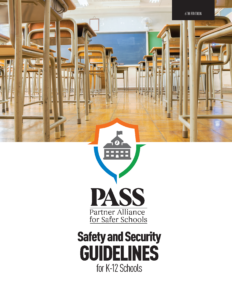What are the top safety and security considerations for mobile classrooms, and how should schools address them? Download our white paper to get the answers
Mobile classrooms are indispensable for addressing space constraints, but their detachment from main campus buildings demands intentional security planning. Schools can ensure mobile units are as safe and secure as permanent facilities by implementing the Partner Alliance for Safer Schools (PASS) tiered recommendations, which span access control, technology integration, policy development, and community engagement. Robust infrastructure, proactive training, and stakeholder collaboration create resilient, productive learning environments prioritizing student and staff safety.
What are mobile classrooms?
Mobile classrooms – often called learning cottages, modulars, portables, or trailers, depending on local terminology – serve as essential solutions for schools experiencing space shortages due to increasing enrollment, renovations, or natural disasters.
What are the challenges of mobile classrooms?
The often-short lead times associated with mobile classroom deployment can mean limited opportunities for comprehensive security planning. Unlike permanent buildings, they may lack integrated infrastructure (e.g., centralized access control, surveillance, or fire suppression systems). Additionally, their placement, often at campus perimeters, can complicate supervision and emergency response. Their temporary nature and separation from the main campus buildings create vulnerabilities related to security, accessibility, and emergency preparedness.
How should schools address the safety and security of mobile classrooms?
To address the additional risks, mobile classrooms should be equipped with the same life safety systems as permanent facilities, including fire alarms, smoke detectors, and emergency communication systems, to ensure consistent protection across the campus. The PASS K-12 Guidelines emphasize a layered security approach — integrating physical, technological, and procedural measures — to mitigate risks.
This white paper provides a road map for school districts to implement robust safety and security measures in mobile classrooms. It addresses the challenges by offering tiered recommendations, detailed technical specifications, and policy frameworks aligned with the PASS holistic approach to school safety, ensuring compliance with PASS standards and fostering safe learning environments.
About PASS
The Partner Alliance for Safer Schools (PASS) is a nonprofit 501(c)(3) bringing together expertise from the education, public safety, and industry communities to develop and support a coordinated approach to making effective and appropriate decisions with respect to safety and security investments. You can download the complete PASS Guidelines here, or check out our PASS Safety and Security Checklist for quick tips on how to get started. These resources—as well as white papers on various topics including barricade devices, lockdown drills, and more—are available at no cost.
Categories
- Access Control
- Classroom Door Locks
- Crime Prevention Through Environmental Design
- Cybersecurity
- Duress Alarm
- In the News
- Legislation
- Lockdown Drills
- New Technologies
- PASS Advisory Council
- PASS Board of Directors
- PASS Partners
- PASS Recommendations
- Preparedness
- Safe School Week
- Safety & Security Guidelines
- School Safety & Security
- Security Best Practices
- Video Surveillance

Ready to get the Guidelines?
The most comprehensive information available on best practices specifically for securing school facilities, vetted extensively by experts across the education, public safety and industry sectors.
